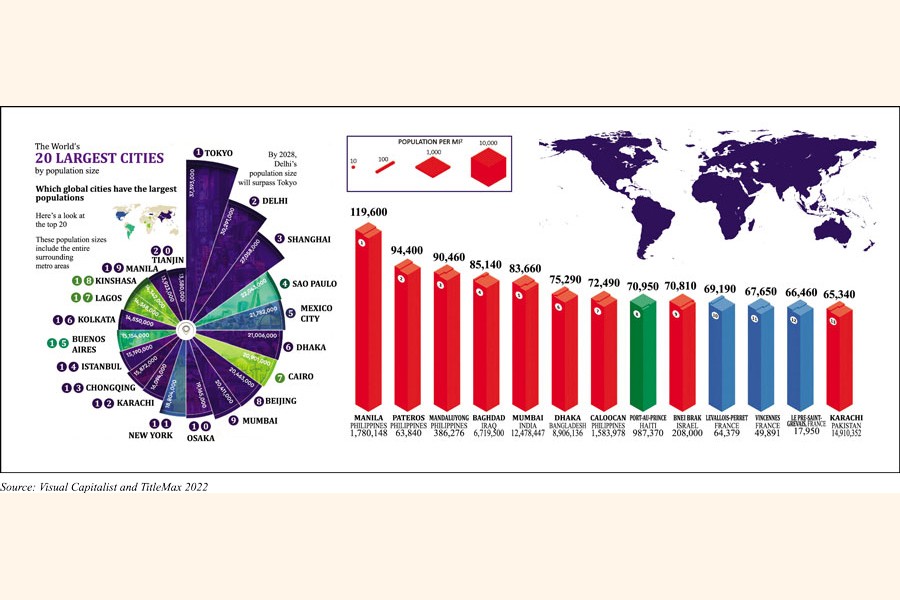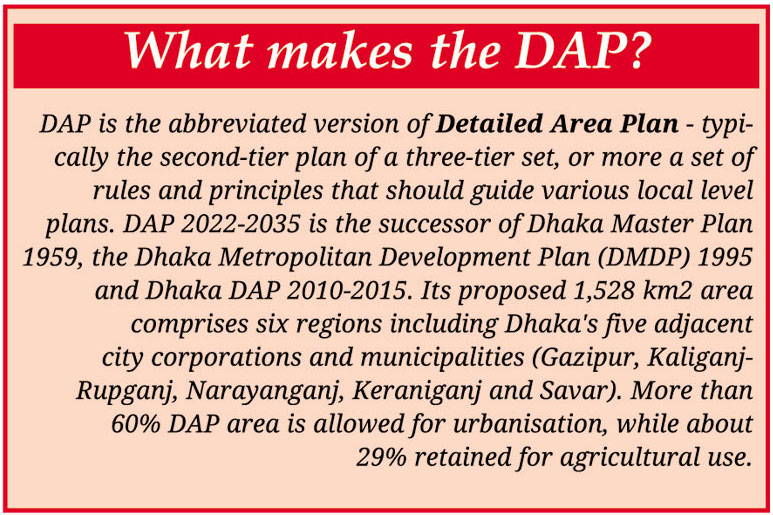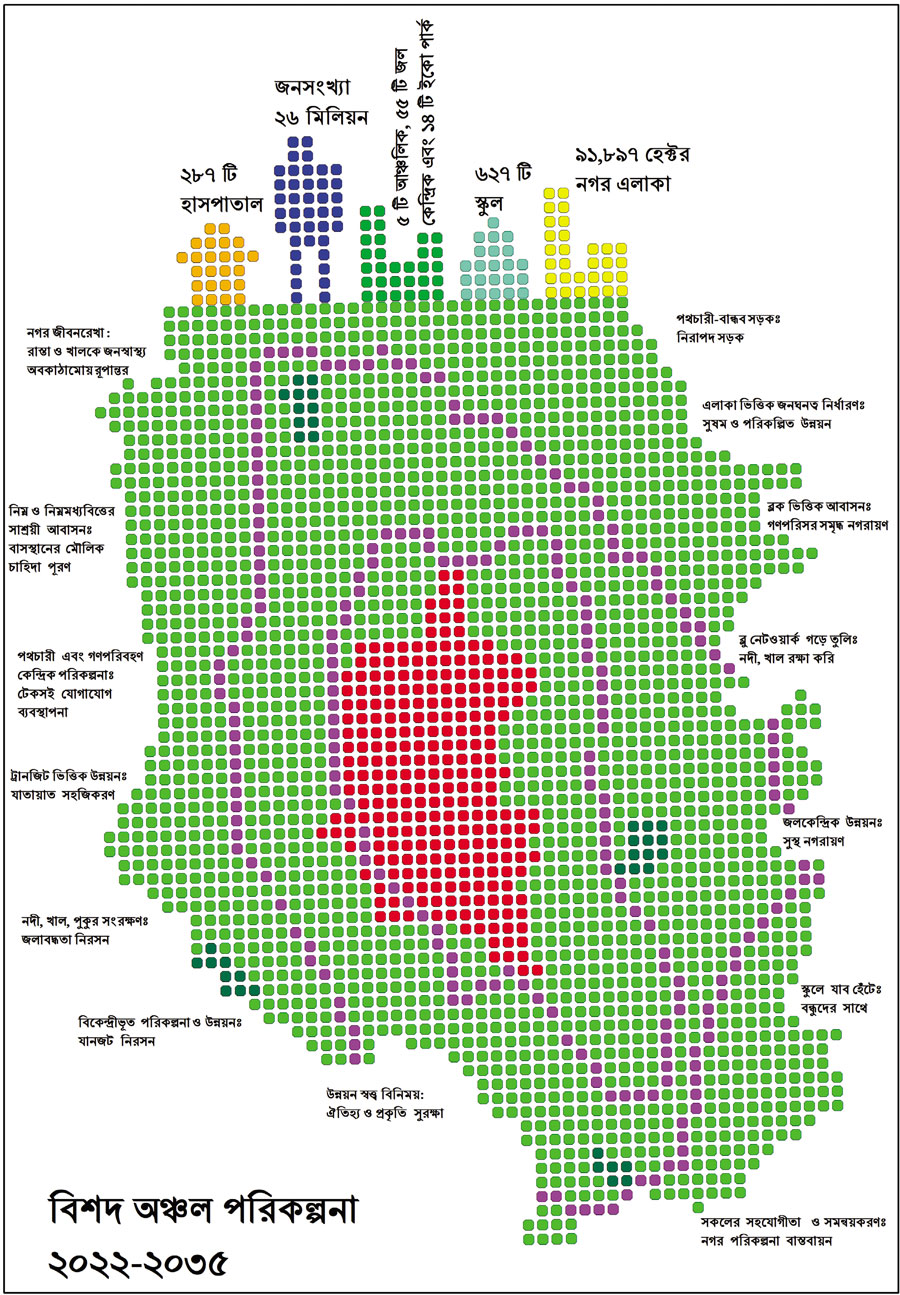
Planning for a planned city
DAP 2022-35: critiques & way forward
Sheikh Serajul Hakim | Thursday, 10 November 2022

 When I came across the newly published Dhaka DAP 2022-2035, it was unlike any public document I had ever seen in Bangladesh! Beautiful it was, not only because it was published in Bangla or because it was stunningly composed with very useful graphic illustrations. Instead, its beauty manifested in how it was founded on a firm philosophical positioning – perhaps the first ever in Bangladesh. A few lines from it read, “this plan is founded on two pillars; first, the inclusiveness that takes account of the needs and ways of life of people from all socio-economic strata and second, re-establish the relation between people and nature”.
When I came across the newly published Dhaka DAP 2022-2035, it was unlike any public document I had ever seen in Bangladesh! Beautiful it was, not only because it was published in Bangla or because it was stunningly composed with very useful graphic illustrations. Instead, its beauty manifested in how it was founded on a firm philosophical positioning – perhaps the first ever in Bangladesh. A few lines from it read, “this plan is founded on two pillars; first, the inclusiveness that takes account of the needs and ways of life of people from all socio-economic strata and second, re-establish the relation between people and nature”.  It boasts of prioritising sectors based on stakeholders’ feedback to improve Dhaka citizens’ quality of life and well-being. High-priority sectors include effective, flexible and pragmatic (mixed) land use that respects diverse lives and livelihoods, the introduction of urban lifeline (integrated transportation) concept, density zoning, education and primary healthcare for all, prioritisation of non-motorised and pedestrian movements, incremental urbanisation, decentralised and community-based waste management, appropriate and integrated development of environmentally/hydrologically sensitive areas and disaster management toward improved resilience. I became hopeful and decided to probe deeper into its two massive volumes.
It boasts of prioritising sectors based on stakeholders’ feedback to improve Dhaka citizens’ quality of life and well-being. High-priority sectors include effective, flexible and pragmatic (mixed) land use that respects diverse lives and livelihoods, the introduction of urban lifeline (integrated transportation) concept, density zoning, education and primary healthcare for all, prioritisation of non-motorised and pedestrian movements, incremental urbanisation, decentralised and community-based waste management, appropriate and integrated development of environmentally/hydrologically sensitive areas and disaster management toward improved resilience. I became hopeful and decided to probe deeper into its two massive volumes.
Hope, however, is the only thing that one can ‘hope for’ in any DAP’s prospect in Bangladesh. Talks with Planner colleagues made us realise that no DAP in Bangladesh could be implemented more than 5% of what was initially planned. Reasons for their failure, especially the immediately prior one in Dhaka (2010), include the lack of any strategic vision based on stakeholder priorities, implementation and monitoring instruments (both monetary and human resources), and homogeneous FAR (Floor Area Ratio) irrespective of local factors and features, neighbourhood and topographic characteristics. Naturally, these failures lead to the ever-swelling density of Dhaka neighbourhoods, various service and utility failures, mounting traffic congestion, and the disappearance of nature from urban life.
The new DAP acknowledges the significance of the regeneration of rivers and canals from sewage drains, new schools and healthcare facilities, regional parks, improved mass transportation system, integrated subterranean utility ducts and agro-flood flow regional management, and attempts to demonstrate means to their provisioning. Overall, it adopts strategies for decentralisation and polycentric growth (i.e. more than one centre) to decongest the central areas of Dhaka by developing rapid transportation and connectivity between Dhaka and its neighbouring five urban centres and townships. Supported by new infrastructure, reduced and area-based FAR and the simultaneous conservation and value-added use of natural and eco-features of this new city jurisdiction, DAP expects to improve the quality of citizen life significantly. For this initial part, at least, most planning problems seemed to have been diagnosed rightly, and planning needs have been identified. These lay the proper scope for novel planning approaches, guidelines and solutions.
What’s the whining ABOUT: Since the gazetted publication of the DAP on August 23, myriad concerns have been voiced by professionals and stakeholder groups from all corners and circles. Despite its six-year-long gestation process (2016-2022) and a five-month-long public hearing (September 2020 to January 2021), widespread discontent has been rife, as writs and lawsuits are plenty. This, however, is not surprising for a city that easily qualifies among the global top 10 list in terms of density and total population. A city marred by numerous challenges is also a hotbed of numerous opinions and debates amongst hundreds of individual and group stakeholders. Concerning the new DAP; I attempt to provide a quick glimpse into the typology of these issues raised by these stakeholder groups.
Question of legalities: A DAP is a lower level/tier plan that must be guided by higher tier plans like the Structure Plan. However, without any gazetted Structure Plan to provide guidance and planning principles, this DAP 2022-2035 appears to be an orphan! A few corners are not even hesitant to call it illegal! DAP’s disregard has further compounded this concern for the legality of the newly published BNBC (Bangladesh National Building Code) 2022, which for some, is another ground-breaking document to date. Writs filed also accuses DAP of violating the provisions of at least three other legal documents, namely the Town Improvement Act 1973, Waterbodies Protection Act 2000 and Acquisition and Requisition Act 2017. New DAP’s rather pragmatic approach allows relatively easy legalisation of houses that violated DAP 2010 and built on floodplains (as in Beri Bandh, Dhaka Udyan etc.)! Then who would not take this same opportunity under this new DAP to construct in critical areas and wait to resolve this violation by paying a fine again? Together, these compromise the becoming of a hydrologically resilient Dhaka and seriously contradict this document’s philosophy, where it allows nature/water to remain and flourish.
Lowered density and differentiated FAR: Simply speaking FAR is the ratio of the total built floor area of a building to the total plot area. For example, a FAR value of 2.0 means one can construct two times more floor area than the plot area on which it is built and distribute this area vertically on several floors. The new DAP criticises the 2008 Imarat Nirman Bidhimala’s basis for determining a homogeneous FAR value for all neighbourhoods disregarding their place-specific characteristics. However, the new DAP’s insistence on reducing density can be criticised similarly for not appraising the reason behind the existence of high-density inner or peripheral locations where most of Dhaka’s ordinary population make a home. It can also be questioned whether this understanding of ordinary people’s housing needs in particular inner-city areas has been adequately addressed in the provisioning of new differentiated FAR and peripheral townships. Could DAP provide enough options for affordable and efficient commuting between these townships and inner working locations within Dhaka as it asks to de-densify inner-city neighbourhoods? Has DAP learnt its lessons from the co/side-by-side existence of higher- and lower-class neighbourhoods and the consequences of the disparity it created in FAR value allocation between adjacent neighbourhoods like Dhanmondi (4.0) and Jigatola (1.8) or Gulshan-Baridhara (5.8) and Badda (1.7)? Not much research was carried out in this regard, probably.
Low-income housing: Little novelty has been noticed in the housing sector, especially in low-income housing for the lower and lower-middle class population. DAP marks only 54 locations for this enormous segment of the population, which allegedly represent 50-60% of the total urban population and 80-90% of the in-migrating population. This number, then, certainly does not feel adequate. In a way, it manifests the uncritical acceptance of slums and their upgrading as solutions to lower-income housing problems and an indication of the failure of the DAP. This responsibility is thus surrendered to the private sector like REHAB, which in reality, has provisioned nothing for the abovementioned class.
Dualities: DAP 2022-35 also involves a lot of dualities. DAP vows freedom to invest; it highlights the need for responsible and responsive investment. But according to REHAB, the DAP’s reduced FAR for 90% of land plots within Dhaka will reduce the built footprint/area in middle and higher-middle-class multifamily apartments by 33-35%. It should also increase the apartment price by 50%, making it unaffordable for buyers and slowing down this somewhat unsung sector. DAP also mentions the need for disaster resilience. As part of disaster preparedness, it proposed many area-wise schools and playgrounds, which people could use during disaster emergencies. It certainly seems good on paper. But within present Dhaka, where could one find these spaces? This has been further compounded by the fact that it has also lifted its bar for mandatory road widening during plan approval – a successful policy used by the 2008 Imarat Nirman Bidhimala. Road widening is essential for easy access and evacuation during hazards. I also did not find much on urban risk assessment and risk-based/adaptive planning, considering Dhaka’s vulnerability to an overdue 8.2-9 magnitude earthquake, which I wrote about elsewhere. Nature Geoscience Journal’s research findings have recently reconfirmed this vulnerability.
Further, contrary to the PM’s goal that no one will remain homeless in Bangladesh, the DAP’s proposed density structure (200-250 person/acre) should instigate immediate homelessness for people currently living in Dhaka (about 531 person/acre). Therefore, the proposed number contradicts the goal. One feels uncertain of what would happen to this vast population and how they would make a living when moved away from the centre toward the peripheral townships.
Inequalities: FAR, Education and Healthcare: One of the prime concerns of the new DAP is its creation of inequality in terms of differentiated FAR allocation. Allegedly RAJUK crumbled under the pressure/persuasion of influential stakeholders and allowed 3-5 FAR value in only about 34 locations (including ‘elite’ neighbourhoods like Gulshan-Basundhara, Dhanmondi, Jalshiri, Jhilmil and Purbachal) of the 346 locations.
In Bangladesh, land has remained the most robust and secured form of investment for petty owners. But the asymmetric allowance of FAR to more than 90% of properties would compel landowners from developing smaller/lower. Compared to their neighbours who might have already built/developed higher using the earlier FAR, the intending inhabitants would now begin to consider themselves as victims. It would undoubtedly create a sense of disparity. It may also lead to illegality and rule violation of various sorts. Although the proposed block-type development aims to resolve this to a certain extent, some specific compensative mechanisms and incentives should have been provisioned to minimise this sense of discrimination.
Further, any development plan (like DAP) must strive for a Just City, where inequalities are identified and neutralised through planning decisions and interventions. A University of Glasgow-led current research project based at Khulna University – Sustainable, Healthy and Learning Cities and Neighbourhoods (SHLC) has recently identified that an acute form of inequality and concentration of poverty exists among Dhaka’s different neighbourhoods. Not every neighbourhood, mahalla and ward enjoys a similar number of schools, healthcare facilities and service quality as expected in a planned city. This issue has not been adequately addressed in the DAP. Although it proposed 627 schools, 285 colleges and 287 healthcare facilities, it neither shows the sites/locations of these proposed facilities nor specify their mode of provisioning and implementation while retaining the question of inequality unresolved.
‘Ifs’ and ‘buts’ and problems with assumptions: As in earlier cases, the DAP is founded on many assumptions and prerequisites. Take, for example, the case of the intended creation of a 574 km long waterway around and through Dhaka. This would be only possible when its long-encroached 26 canals out of at least 43 could be reclaimed. But given our experience, reclamation using legal means often takes years, if not decades. It required the DAP to provide necessary planning/policy instruments to help organisations like DNCC and WASA to enact swiftly. In reality, no such provisioning has been found.
As in earlier cases, the DAP is founded on many assumptions and prerequisites. Take, for example, the case of the intended creation of a 574 km long waterway around and through Dhaka. This would be only possible when its long-encroached 26 canals out of at least 43 could be reclaimed. But given our experience, reclamation using legal means often takes years, if not decades. It required the DAP to provide necessary planning/policy instruments to help organisations like DNCC and WASA to enact swiftly. In reality, no such provisioning has been found.
Similarly, the DAP proposes conservation policies to save eco-sensitive lands (floodplains and agricultural lands). It introduces a creative tool called TDR (Transfer of Development Rights) – to help landowners compensate for their inability to develop on sensitive land by co-developing with another property owner. But as in many earlier cases in Bangladesh, paper principles seldom translate into tangible actions. Why and how would someone from Purbachal be willing to share a property with an agricultural landowner? What organisation would monitor the infringements on sensitive lands and waterbodies? What eco-sensitive use might be assigned to these lands that would, at the same time, yield excellent economic returns and discourage people from various violations? Based on the unique landscape characteristics of these floodplain areas, clear and strict development guidelines needed to be in place; leaving no room for interpretation retaining its hydro-cultural identity.
In fear of density: The DAP seems to have developed a particular fear of density. But density may not always be ‘the evil’. In most parts of the world, urbanists and planners are pushing to increase inner-city density. In Hong Kong and New York City centres, the tall ‘pencil’ towers and skyscraper-studded skyline manifest below a very high, tolerable level of density. Many other cities from the developing world also support a similar density structure to Dhaka. Simultaneously, these cities boast excellent natural resources and traffic management and render a very high quality of urban utility/service.
Sustainability and urban footprint go hand to hand. The legendary American urbanist Jane Jacobs wrote The Death and Life of Great American Cities in 1961, lamenting the car-dependent, sprawling city planning in the US and how it produced a non-humane, mechanised, and socially isolated urban fabric. These cities are also one of the least sustainable in the world by any standards. Therefore, it would be hard for the DAP to defend that reducing FAR in most inner-city neighbourhoods/wards within Dhaka and not even trying to densify some of these neighbourhoods, even on a piloting basis, does not suffice.
Further, as in many developing world cities, density depends on the number of families/households living within a building footprint, i.e. its total square metre of space. However, despite reducing FAR, no limit for the maximum number of occupants/households has been specified. Therefore, there is a possibility that landowners may opt for building even smaller-sized apartments with a lower FAR and still house a similar number of tenants, thus retaining the same density level contrary to DAP intentions!
It is also ironic for the DAP to conceptualise and implement policies like road widening. In Old Dhaka, it opts for improving service delivery and exercising better control over its land use by widening its narrow alleys and mixed and often exotic land use and fabric that shapes Old Dhaka’s unique cultural identity. But it does not attempt to do the same to the much-needed improvement of the newer ‘peripheral’ parts of Dhaka having 6’-8’ wide streets. Going back to the modernisation of Old Dhaka, the new DAP does not explain for what particular incentive these residents would give up their current usage of buildings. Although the concept of TDR has been proposed here as well, in the context of the particular pollical economy of Bangladesh, the behaviour of the ‘receiving’ counterpart is yet to be seen in response to the ‘sending’ part’s transfer of rights.
Similarly, the block-type housing development, despite its potential as a game changer, seems impossible without proper guardianship and a legal framework that would compel the formation of development groups like cooperatives and/or societies. In a nation where society is vastly bifurcated according to many social, political and religious lines and is dominated by extreme individualism, it is hard to digest that property could possibly be developed through group ownership. Like everything else, it shows all the symptoms of becoming another site for widespread legal violations and illegal transactions.
Capacity and inter-organisational coordination and collaboration: The governance of about a 1,600 km2 large and densely populated city like Dhaka is almost an impossible task with a centralised, bureaucratic and corrupt organisation like RAJUK. The questions of capacity and collaboration gain further ground when RAJUK itself declares that 87% of the total buildings in Dhaka are illegal or unauthorised. The good part is that this is probably the first time in Bangladesh that a document like DAP outlines the framework of an Integrated City Government headed by elected local government leadership. Although quite promising, the DAP does not explain when and to which extent RAJUK is prepared to share/designate/give up its responsibility for development control and improve its capacity to coordinate and collaborate better. The scepticism intensifies when the new DAP is accused of not making enough community consultations during its inception and preparation. Plans, such as DAPs, must be prepared bottom-up, tallying ward-level problems and assets/resources.
Epilogue: Every time a new DAP is published, the old challenges return. Could RAJUK do it? Undoubtedly, in nations like Bangladesh, the speed of urbanisation precedes the pace of decision-making, plan-making and implementation. Without necessary instruments, enforcement and monitoring remain even weaker.
However, as I said in the beginning, this DAP has at least touched on many fundamental problems, departed from conservative elements and mindsets, and pioneered novel philosophies and instruments. Its move away from land acquisition-based and sites and services (plot-based) housing and opting for block-based development, emphasis on overlay zones and guided mixed-use development, ToD and the pedestrian, hydro-agrarian conservation, traditional livelihoods and development approach (dig and mound) and seem to be the right beginning. A ray of hope in the right direction, it smells fresh and appears like a silver lining in the dark sky. The effort is a move forward from a merely physical solution toward a philosophical journey.
But a city like Dhaka is an assemblage of natural and manmade, rich and poor, and local and regional — a combination of everything. It is no wonder that strategic masters like the Mughals chose Dhaka as their provincial capital, fully equipped to serve the socio-cultural-economic premises of an entire region. Maybe the solution to Dhaka’s problems does not depend entirely on the success/proper implementation of DAP or how well or poorly it is planned. By looking at Dhaka as an all-important assemblage, a national-level policy change like decentralisation is vital. A DAP can only be adequately critiqued in that case.
The developed country we aspire to be in the not-so-distant future is less about materiality and wealth accumulation and more about mindsets and attitudes. To develop, we must plan without compromising the double ‘eco’: Ecology and Economy. In isolation, none would sustain ‘true’ development. The new DAP certainly shows great promise for that and deserves appreciation. More details are to be worked out, amendments are required, and voices of all corners and circles must be accommodated. An eco-sensible pragmatism with spatial justice is necessary.
Sheikh Serajul Hakim is an Educator and Architect, Architecture Discipline, Khulna University, Bangladesh.
serajulhakim@arch.ku.ac.bd